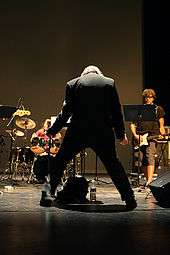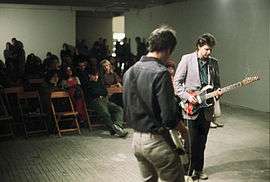Glenn Branca
| Glenn Branca | |
|---|---|
|
Glenn Branca performing at Hallwalls in the 1980s | |
| Background information | |
| Born |
October 6, 1948 Harrisburg, Pennsylvania, United States |
| Genres | Modern classical, avant-garde, no wave, experimental, noise, minimalism, totalism |
| Occupation(s) | Composer, musician, luthier |
| Instruments | Guitar, prepared guitar |
| Years active | 1967–present |
| Labels | 99, Neutral |
| Associated acts | Theoretical Girls, The Static |
| Website | Official website |
Glenn Branca (born October 6, 1948) is an American avant-garde composer and guitarist known for his use of volume, alternative guitar tunings, repetition, droning, and the harmonic series. Branca received a 2009 Foundation for Contemporary Arts Grants to Artists Award.
Life and work
Beginnings: 1960s and early 1970s
Born in Harrisburg, Pennsylvania, Branca started playing the guitar at age 15. He also created a number of tape sound art collage pieces for his own amusement. After attending York College in 1966–1967, he started the short-lived cover band The Crystal Ship with Al Whiteside and Dave Speece in the summer of 1967. In the early 1970s, Branca studied theater at Emerson College in Boston. In 1973, he moved from Boston to London with his then girlfriend Meg English.
After moving back to Boston in 1974, he met John Rehberger. While there, he began experimenting with sound as the founder of an experimental theater group called Bastard Theatre in 1975. Working out of a loft on Massachusetts Avenue they wrote and produced the music/theater piece Anthropophagoi for a two-week run. In 1976, The Bastard Theatre's second production was What Actually Happened at a new loft in Central Square, Cambridge and later at The Boston Arts Group. Considering the unconventional and sometimes confrontational nature of the productions, the shows still received interested reviews from the Phoenix and The Boston Globe. All music for Bastard Theatre productions were original compositions by Branca or Rehberger and were performed live by the actor/musicians.[1]
New York: Late 1970s and 1980s
In 1976 Branca moved to New York City to continue in experimental theater. He encountered the N. Dodo Band and watched their rehearsals in Chelsea, hoping to use the space for a theater production. Branca spent time with one of its members, Jeffrey Lohn, who introduced him to bands such as Suicide. The two began forming a theater group when Branca decided he wanted to form a band, which he called the Static and later Theoretical Girls. Branca put up posters to recruit members, and after seeing one of the posters, Lohn expressed interest.[2]
Lohn's girlfriend Margaret De Wys joined the band as its bassist, and they borrowed drummer Mike Anthol from the N. Dodo Band. Artist Dan Graham booked the band at Franklin Furnace for its first performance.[3] The group reformed in 1977 with Wharton Tiers as its drummer.[3][4] Branca also recorded Barbara Ess's band Y Pants for their debut release on 99 Records and performed with Rhys Chatham's Guitar Trio in 1977,[5] a noise music experience that was very important in the development of his compositional voice (Branca 1979). In 1982, Branca launched his own record label, Neutral Records, releasing Y Pants' LP and the first few records by New York noise rockers Sonic Youth.
In the early 1980s, he released his first album under his own name, Lesson No. 1.[6] In the same year, he composed several medium-length compositions for electric guitar ensembles, including The Ascension (1981) and Indeterminate Activity of Resultant Masses (1981). The Ascension appeared on his second same titled solo album in 1981, Indeterminate Activity of Resultant Masses was released no earlier than 2008 on CD.
Soon after these two compositions, he began composing symphonies for orchestras of electric guitars and percussion, which blended droning industrial cacophony and microtonality with quasi-mysticism and advanced mathematics. Starting with Symphony No. 3 ("Gloria") (1983), he began to systematically compose for the harmonic series, which he considered to be the structure underlying not only all music but most human endeavors.[7] In this project, Branca was initially influenced by the writings of Dane Rudhyar, Hermann von Helmholtz, and Harry Partch.
He also built several electrically amplified instruments of his own invention, expanding his ensemble beyond the guitar. A few of these instruments were third bridge zithers he called "harmonic guitars". He also built instruments with many strings that he called "mallet guitars" because they were percussion instruments played with drumsticks and monotone electric cymbaloms with an additional third bridge on resonating positions. Early members of his group included Thurston Moore and Lee Ranaldo of Sonic Youth, Page Hamilton of Helmet, Phil Kline of The Del-Byzanteens, and several members of Swans including Michael Gira, Dan Braun, and Algis Kizys.[8]
Recent work: 1990s to present

In the early 1990s, David Baratier attempted to document Branca's teaching style in They Walked in Line. In September 1996, The Glenn Branca Ensemble played at the opening ceremony for the Aarhus Festival in Denmark. The ceremony took place in the Musikhuset Opera House, and in the audience were the Queen of Denmark, the mayor of Aarhus and other dignitaries. After receiving more than 25 major commissions since 1981, Branca's music has finally begun to receive academic attention. Some scholars, most prominently Kyle Gann, consider him (and Rhys Chatham) to be a member of the totalist school of post-minimalism.
Beginning with Symphony No. 7, Branca began composing for traditional orchestra, although he never abandoned the electric guitar. Branca also plays duets for excessively amplified guitars with his wife, Reg Bloor, and conducted his 13th symphony for 100 electric guitars at the base of the World Trade Center in New York City on June 13, 2001, less than three months before the center's destruction in the September 11 attacks. Since that time his 100 guitar piece has been performed in cities all over the U.S. and Europe. In 2008, he wrote his 14th Symphony, entitled "The Harmonic Series", which is performed by a traditional orchestra. The first movement of this symphony, named "2,000,000,000 Light Years From Home" premiered in St. Louis performed by the St. Louis Symphony Orchestra conducted by David Robertson on November 13, 2008. This was the 12th major orchestra to perform Branca's orchestral work since 1986.
In 2008, he was awarded a grant from the Foundation for Contemporary Arts Grants to Artists Award as well as a CAPS grant in 1983, an award from the National Endowment for the Arts in 1988 and a NYSCA grant in 1998, all for music composition. In 2010, Fortissimo Records re-released Branca's 1981 album The Ascension as a special edition on 180 grams vinyl and Branca wrote a piece The Ascension: The Sequel, which was released in the same year on the label Systems Neutralizers. This follow up piece led to new interest in his work and notable performances at Primavera Sound Festival 2011 and Villette Sonique 2011.
In October 2014, Branca premiered Ascension Three, touring it with Glenn Branca Ensemble in Europe. In February 2015, Branca's second 100 electric guitars piece, "Symphony No. 16 (Orgasm)", was premiered at Cité de la Musique in Paris. The Light (for David) for four guitars, bass and drums, premiered in October 2016 at the Roulette in Brooklyn.[9]
Discography
- Lesson No. 1 (99 Records, 1980)
- The Ascension (99 Records, 1981, Acute Records 2001, Fortissimo Records 2010)
- Indeterminate Activity of Resultant Masses, (Atavistic, 1981/2007)
- Bad Smells from Who Are You Staring At? with John Giorno (GPS, 1982)
- Chicago 82 – A Dip in the Lake (Crepuscule, 1983)
- Symphony No. 3 (Gloria) (Atavistic, 1983)
- Symphony No. 1 (Tonal Plexus) (ROIR, 1983)
- The Belly of an Architect (Crepuscule, 1987)
- Symphony No. 6 (Devil Choirs at the Gates of Heaven) (Blast First/Atavistic, 1989)
- Symphony No. 2 (The Peak of the Sacred) (Atavistic, 1992)
- The World Upside Down (Crepuscule, 1992)
- The Mysteries (Symphonies Nos. 8 & 10) (Blast First/Atavistic, 1994)
- Les Honneurs Du Pied from Century XXI USA 2-Electric/Acoustic (various) (New Tone, 1994)
- Symphony No. 9 (l'eve future) (Point, 1995)
- Faspeedelaybop from Just Another Asshole (various) (Atavistic, 1995)
- Songs '77–'79 (Atavistic, 1996)
- Symphony No. 5 (Describing Planes of an Expanding Hypersphere) (Atavistic, 1999)
- Empty Blue (In Between, 2000)
- Movement Within from Renegade Heaven by Bang on a Can (Cantaloupe, 2000)
- The Mothman Prophecies [Soundtrack] (contributed 1-minute "Collage") (Lakeshore Records, 2002)
- The Ascension: The Sequel (Systems Neutralizers, 2010)
- Symphony No. 7 (Graz) (Systems Neutralizers, 2011)
Footnotes
- ↑ Marc Masters, p. 112
- ↑ Moore and Coley, p. 52–56
- 1 2 Moore and Coley, p. 56
- ↑ Masters, p. 114
- ↑ Masters, p. 124
- ↑ Masters, p. 126
- ↑ Masters, p. 115
- ↑ Masters, pp. 114–118
- ↑ "David Bowie as Muse? Why One Composer Says So" by Allan Kozinn, The New York Times, October 7, 2016
See also
- Mudd Club
- Tier 3
- Just Another Asshole
- New wave music
- No Wave Cinema
- No wave
- Noise Fest
- Experimental musical instrument
- Noise music
- List of noise musicians
- Post-punk
References
- Goldberg, RoseLee (1988). Performance: Live Art Since 1960. New York: Harry N. Abrams.
- Hegarty, Paul (2007). Noise/Music: A History. Continuum International Publishing Group.
- Masters, Marc (2007). No Wave. London: Black Dog Publishing.
- Moore, Thurston; Coley, Byron (2008). Post-Punk. Underground. New York. 1976–1980. Abrams Image. ISBN 978-0-8109-9543-7.
Further reading
- Branca, Glenn (November 1979). New York: Rhys Chatham. New York Rocker, 16.
- Cole Gagne: "Glenn Branca", Grove Music Online, ed. L. Macy (Accessed January 1, 2006), (subscription access)
- John Rockwell: "All American Music" (Knopf, 1983)
- John Schaeffer: "New Sounds" (Harper and Row, 1987)
- Tom Johnson: "The Voice Of New Music" (Het Apollohuis, 1989)
- Cole Gagne: "Sonic Transports" (De Falco, 1990)
- Cole Gagne: "Soundpieces II" (Scarecrow Press, 1992)
- Alec Foege: "Confusion is Next" (St. Martins, 1994)
- Geoff Smith and Nicola Walker: "New Voices" (Amadeus Press, 1995)
- William Duckworth: "Talking Music" (Schirmer, 1995)
- Bart Hopkin: "Musical Instrument Design" (See Sharp Press, 1996)
- Kyle Gann: "American Music in The 20th Century" (Schirmer, 1997)
- Bill Milkowski: "Rockers, Jazzbos and Visionaries" (Billboard Books, 1998)
- Roni Sarig: "The Secret History Of Rock" (Billboard Books, 1998)
- Bill Martin: "Avant Rock" (Open Court, 2002)
External links
- Official website
- EST Interview by and (c) Brian Duguid.
- Theoretical Girls by Paris Transatlantic magazine
- Glenn Branca interview
- Glenn Branca: "Acoustic Phenomena" (3:59) published on the Tellus Audio Cassette Magazine @ Ubuweb
